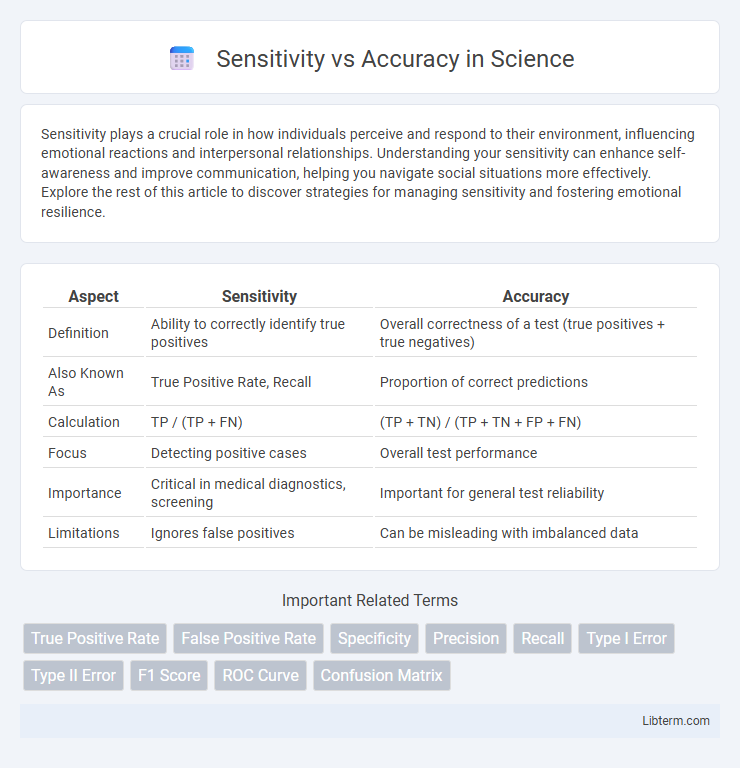Sensitivity plays a crucial role in how individuals perceive and respond to their environment, influencing emotional reactions and interpersonal relationships. Understanding your sensitivity can enhance self-awareness and improve communication, helping you navigate social situations more effectively. Explore the rest of this article to discover strategies for managing sensitivity and fostering emotional resilience.
Table of Comparison
| Aspect | Sensitivity | Accuracy |
|---|---|---|
| Definition | Ability to correctly identify true positives | Overall correctness of a test (true positives + true negatives) |
| Also Known As | True Positive Rate, Recall | Proportion of correct predictions |
| Calculation | TP / (TP + FN) | (TP + TN) / (TP + TN + FP + FN) |
| Focus | Detecting positive cases | Overall test performance |
| Importance | Critical in medical diagnostics, screening | Important for general test reliability |
| Limitations | Ignores false positives | Can be misleading with imbalanced data |
Understanding Sensitivity and Accuracy
Sensitivity measures a test's ability to correctly identify true positive cases, indicating how effectively it detects a condition when present. Accuracy quantifies the overall correctness of a test by comparing the total number of true positive and true negative results against all evaluated cases. Understanding sensitivity and accuracy is crucial for evaluating diagnostic tests, optimizing clinical decision-making, and improving patient outcomes.
Key Definitions: Sensitivity vs Accuracy
Sensitivity measures the proportion of true positives correctly identified by a diagnostic test, reflecting its ability to detect actual cases. Accuracy represents the overall correctness of the test, calculated as the sum of true positives and true negatives divided by the total number of cases. High sensitivity is crucial for minimizing false negatives, while accuracy provides a balanced view of both false positives and negatives in classification performance.
Importance in Data Analysis
Sensitivity measures the ability of a model to correctly identify true positives, which is crucial in scenarios requiring detection of rare or critical events. Accuracy represents the overall correctness of predictions but can be misleading in imbalanced datasets where true negatives dominate. Prioritizing sensitivity over accuracy is essential in data analysis when missing positive cases has significant consequences, such as in medical diagnostics or fraud detection.
Applications in Medical Testing
Sensitivity measures a medical test's ability to correctly identify patients with a condition, minimizing false negatives, whereas accuracy reflects the overall correctness of test results, balancing true positives and true negatives. High sensitivity is crucial in screening tests for diseases like cancer or infectious diseases to ensure early detection and timely treatment. Applications such as HIV screening and tuberculosis diagnostics prioritize sensitivity to reduce missed cases, while accuracy is essential in confirmatory tests to provide reliable diagnoses.
Statistical Implications
Sensitivity measures the proportion of true positives correctly identified by a test, emphasizing its ability to detect actual cases, while accuracy reflects the overall proportion of correct predictions, including true positives and true negatives. High sensitivity is crucial in contexts where missing positive cases leads to significant consequences, but it may increase false positives, affecting accuracy. Statistical implications include the trade-off between minimizing type II errors (false negatives) and maintaining balanced predictive validity, necessitating careful threshold selection based on the specific diagnostic or predictive goals.
Sensitivity in Machine Learning
Sensitivity in machine learning measures the proportion of true positive cases correctly identified by a model, reflecting its ability to detect relevant instances. High sensitivity is crucial in applications like medical diagnosis and fraud detection, where missing positive cases can lead to severe consequences. Optimizing sensitivity often involves trade-offs with specificity, requiring careful threshold adjustment to balance false negatives and false positives.
Accuracy in Predictive Models
Accuracy in predictive models measures the proportion of correct predictions among the total predictions, reflecting the model's overall effectiveness. High accuracy indicates that the model reliably classifies both positive and negative cases, making it suitable for balanced datasets where classes are evenly distributed. In scenarios with imbalanced data, optimizing accuracy alone can be misleading, necessitating complementary metrics like sensitivity to gain a comprehensive evaluation.
Trade-offs Between Sensitivity and Accuracy
Sensitivity measures the true positive rate, reflecting a model's ability to correctly identify relevant instances, while accuracy represents the overall proportion of correct predictions. Increasing sensitivity often leads to more false positives, causing a decline in accuracy, highlighting a critical trade-off in model performance. Balancing sensitivity and accuracy requires optimizing thresholds to meet specific application needs, such as patient diagnosis or fraud detection.
Factors Affecting Sensitivity and Accuracy
Factors affecting sensitivity include the quality of the data, the threshold settings in diagnostic tests, and the prevalence of the condition being detected. Accuracy is influenced by both sensitivity and specificity, sample size, and measurement precision. Variability in test execution and external environmental conditions also impact the reliability of sensitivity and accuracy metrics.
Enhancing Sensitivity and Accuracy in Practice
Enhancing sensitivity involves improving the true positive rate to identify more relevant cases, while accuracy balances both true positives and true negatives for overall correctness. Techniques like refining feature selection, increasing sample size, and optimizing model parameters directly impact sensitivity and accuracy in machine learning models. Continuous validation using cross-validation and real-world data ensures sustained improvements in sensitivity and accuracy across applications.
Sensitivity Infographic

 libterm.com
libterm.com